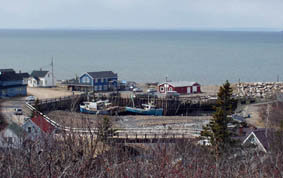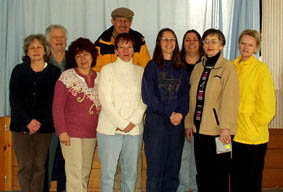
![]()
Volume 7, No. 2
Promoting Cooperation to Maintain and Enhance
Environmental Quality in the Gulf of Maine
|
||||||||||
|
Regular columns |
|
|
|||||||
|
|
|
|
Browse the archive |
|
|
|
|
Gulf Voices
The view from Harbourville
By Scott Milsom
There are a number of roads in Kings County, Nova Scotia that climb out of the Annapolis Valley over the North Mountain to small communities along the Bay of Fundy, but none offer a more stirring panorama than the road leading north from Berwick to Harbourville. As I coast down the north slope of the mountain on a crystal-clear Friday morning, I see the familiar blue-sky-meets-blue-sea vista, punctuated only by the cliffs of Ile Haute at the mouth of Minas Channel and the far shore of Cumberland County and Cape d'Or.
 |
| Harbourville, Nova Scotia |
I've come to try to get a sense of what moves this little community of 250 to 300 people, and to that end I've agreed to meet local resident Holly MacDonald in the Harbourville Community Hall. I am met by Holly and about a half-dozen other women active in the Harbourville Restoration Society (HRS), which, among other things, is responsible for the running of the hall. The women are busy readying the hall for an upcoming community supper.
The people of Harbourville, through the HRS, have been working for a number of years to fix the community's crumbling wharves. In days gone by, Harbourville was the busiest port on the Nova Scotian side of Fundy, but as sea-borne commerce declined, the wharves were sorely neglected. The HRS was founded in 1999 to address the need for major repairs.
"The provincial Department of Economic Development pledged $200,000 some time ago, but it was contingent on our ability to find matching funds from other sources," says Holly, who serves on the HRS's Board.
"Just yesterday, we received word from the Atlantic Canada Opportunities Agency (ACOA) that they're going to pitch in with $250,000." With funding already secured for wharf repairs through an agreement between the Annapolis Valley First Nation and the federal Department of Fisheries, the money will go a long way. They still need about another $500,000, "but we're delighted with this most recent news. Fixing the wharf will be a big boost for the community, and it will do wonders for tourism in the area."
 |
| A determined Harbourville Restoration Society is raising the money to restore the village's wharf. Photos of Harbourville and its restoration society by Belinda Misner |
Among the women at the hall this morning is Harbourville native Mary DesRoches. After coffee, Mary takes me on a visit next door at the home of life-long Harbourville resident Jenny Morton. She invites us into her living room, which commands a lovely Fundy view.
"I was born in this house," Jenny tells me. "My Dad used to drive the mail between Berwick and Harbourville, back in the days, long ago, when there was still a post office here." Jenny can remember back to the 1930s, a time when Harbourville was a bustling port. "Groceries would come by boat from Saint John, and at one time there were five stores here, and two hotels," she says. "In the 50s, we had a dance hall and people of all ages would come. Local musicians would play country music, and though there wasn't supposed to be any drinking, bottles got passed around. But there was never any trouble."
At one time, there were lighthouses both in Harbourville and on Ile Haute, and Jenny remembers a particular Christmas tradition that developed. "The lightkeeper on Ile Haute would be very isolated from the rest of the world, especially in winter," Jenny explains, "and people in Harbourville developed the habit of lighting a bonfire on Christmas Eve as a way of wishing him and his family a Merry Christmas. He would signal back with a fire of his own to let us know that all was well."
Mary, who attended elementary school in the two-room schoolhouse that is now the Community Hall, remembers the Harbourville lighthouse. "At one time, my father was the lightkeeper there, but the Coast Guard closed it down in the 1950s," she says. "I remember getting out of school one day in the early 1960s, and there was the Coast Guard, tearing down the light. I was devastated and angry too, because there was nothing wrong with the structure. It was a lesson to me as a young person that if people in communities want to be heard, well, they had better start speaking up." The light on Ile Haute is still operated by the Coast Guard, though it has been automated since the 1950s.
Back at the hall, I remark that the people of Harbourville seem very welcoming to people who come here from away. Lois Bearden, one of the women who has busied herself through the morning here replies, "I'm one of them. Back in the 70s, Russia Road was pretty much 'hippy central.' My husband's Mom was a Cajun, and he didn't want to go to Vietnam, so we figured it was a good time to come up here and look into his Acadian roots. We got to Harbourville and ran out of gas. We've been here ever since."
As I head back up over the north slope of the North Mountain toward Berwick, I take one last look in the rear-view mirror of the lovely vision of Ile Haute, then check my gas gauge, seeing that I'll be fine. But so what? Even if I run out of gas, I'll simply coast back down to Harbourville, where I know I'll be well taken care of.
The above excerpt is from an article that appeared in the January/February issue of Coastal Communities News, the magazine of Nova Scotia's Coastal Communities Network (CCN). Scott Milsom is the editor. For more about CCN, visit its Web site at http://www.coastalcommunities.ns.cs.